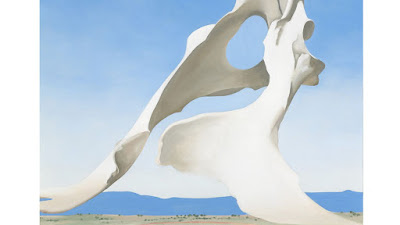 |
| Georgia O'Keefe, Grey Blue and Black Pink Circle, 1929 |
It was a great pleasure to visit the Georgia O'Keefe exhibition at the Centre Pompidou. Particularly because a number of people had said that the exhibition wasn't very interesting. Sometimes low expectations can lead to the most enjoyable exhibitions!
 |
| Georgia O'Keefe, Series 1 - no. 4, and Series 1 - no. 3, 1918 |
For me, the most surprising discovery at the Pompidou exhibition was that O'Keefe was an abstract painter. In my—and no doubt many others'—minds, O'Keefe was a painter of flowers bursting into bloom in the shape and form of vaginas and other female body parts. But really, O'Keefe was an explorer of colour and light, shape and definition of form through colour from the earliest works on. We see an ongoing interrogation of colour as light to create dimensionality, often in forms that become abstract thanks to their push at and beyond the picture frame. It is true that O'Keefe's paintings recall the female form, but they are also about much more: O'Keefe brings a connection between abstraction, the woman's body and nature to the development of modern art. On the one hand, as we know, the paintings represent a mass of skin and blossoming flesh, ripe for the picking. In this, the connection to surrealism is also very apparent. Like the surrealists, however, this obsession with the woman's body also connects to a dreamlike tendency. This can be seen especially in surrealist works painted in the 1920s and 1930s by artists such as Ithell Colquhoun. Thus, on the other hand, we are under no illusion of the reality of O'Keefe's sensuous forms.
 |
| Georgia O'Keefe, Jimson Weed/White Flower No. 1, 1932 |
Beyond O'Keefe's skilful use of colour, the exhibition shows her deep understanding of colour. I was in awe at her sophisticated grasp of the relations between colour, how different colours interact on the canvas, how the introduction of white or black changed the mood and tone of the representation, how shape informs the perception of colour. This is not surprising given that she was actively painting over decades when these questions were being asked by painters in her midst. However, what is surprising is how the exploration of colour comes together with a very precise and careful use of her medium of paint. She is also interested in transparency and opacity, shapes to look at and look into, as well as the more abstract and pure philosophies of colour and paint. Thus, O'Keefe is, in many ways, doing much more than her contemporaries.
 |
| Georgia O'Keefe, White and Blue Flower Shapes, 1919 |
I was also delighted to see the connections between O'Keefe's paintings and explorations in lens-based media that began to flourish in her lifetime. Her focus on the shape and contours of the natural world, the turning of leaves into abstract patterns in light and shade (and for O'Keefe, colour) are consistent with what photographers around her were doing. The flowers becoming abstract may be recognized as Mapplethorpe before his time, but they also resemble some of the images that were being produced in abstract photography. From Man Ray's surrealist photography to postwar German realism by artists such as Karl Blossfeldt, O'Keefe's painting is absolutely of its time. In addition, O'Keefe's painting is incredibly cinematic. I kept finding myself thinking about the images of 1920s and 1930s avant-garde filmmakers: in closeup, exploring the object in detail as it burst out of the frame. This idea of motion inside and outwards from the four sides of a frame, the explosion, the moment of waking up in the process of coming to life was of course the concern of the filmmakers in her midst. I couldn't help using the language of cinema when I was thinking about how to describe her work. The soft petals, skin of the woman's body, in "close up," represented the very desire of the film theorists for more than the human eye could see. The same can be said of the undulating landscapes that double as naked women. In particular, their capture of the sensuousness of the body was considered to be the raison d'être of the cinematic camera.
 |
| Georgia O'Keefe, Sky Above Clouds/ Yellow Horizon and Clouds, 1976-77 |
In addition to the photography and cinema connections, O'Keefe's concerns were familiar from what Mondrian was doing. Even though her work is not about line and breaking the boundaries of geometrical form, it's about flatness. In this, particularly in the later landscapes, O'Keefe's work is about perspective and seeing the world anew. And when the flowers and other natural forms burst out of their frames, they challenge the threshold in a different, but related way to Mondrian. The abstractions of landscape that the exhibition called the Cosmos were all about interrogating perspective through a fascination for areas of colour.
 |
| Georgia O'Keefe, Pelvis with the Distance, 1943 |
Ultimately, with all of these references, it's difficult not to see O'Keefe's art as steeped in European traditions of painting. Which, in turn, make this retrospective at the Centre Pompidou a well overdue event. It's a great shame to think that without her famous photographer husband bringing her work to the public eye, these great paintings may have gone unnoticed altogether.
No comments:
Post a Comment